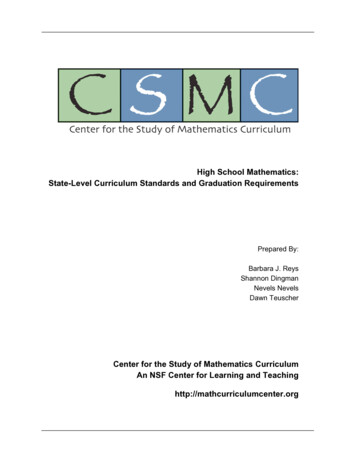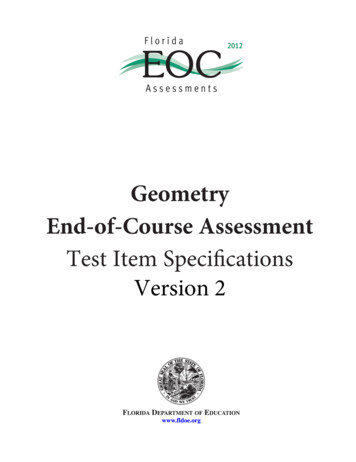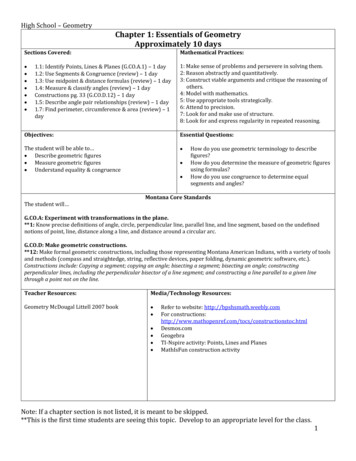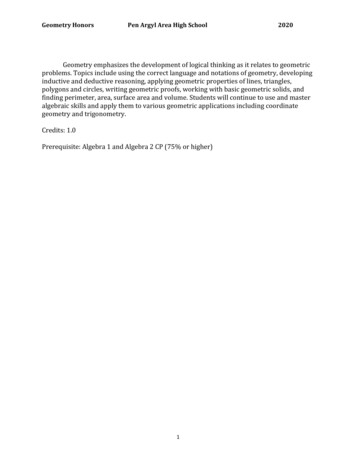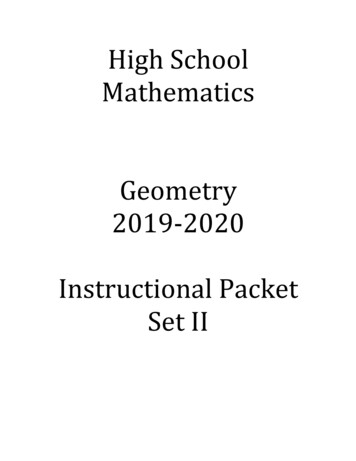
Transcription
High SchoolMathematicsGeometry2019-2020Instructional PacketSet II
Students:Work at your own pace. Contact yourteacher for support as needed.C & I Department
Name8-1ClassDateReteachingTranslationsA translation is a type of transformation. In a translation, a geometric figurechanges position, but does not change shape or size. The original figure is calledthe preimage and the figure following transformation is the image.The diagram at the right shows a translation in the coordinateplane. The preimage is ABC. The image is A′B′C′.Each point of ABC has moved 5 units left and 2 units up.Moving left is in the negative x direction, and moving up isin the positive y direction. So each (x, y) pair in ABC ismapped to (x – 5, y 2) in A′B′C ′. The function notationT –5, 2 ( ABC) A′B′C ′ describes this translation.All translations are rigid motions because they preservedistance and angle measures.ProblemWhat are the vertices of T 5, –1 (WXYZ)?Graph the image of WXYZ.T 5,–1 (W) (–4 5, 1 – 1), or W ′(1, 0)T 5, –1 (X) (–4 5, 4 – 1), or X ′(1, 3)T 5, –1 (Y) (–1 5, 4 – 1), or Y ′(4, 3)T 5, –1 (Z) (–1 5, 1 – 1), or Z′(4, 0)ExercisesUse the rule to find the vertices of the image.1. T 2, –3 ( MNO)2. T –1, 0 (JKLM)Pearson Texas Geometry
Name8-1ClassReteaching (continued)TranslationsProblemWhat rule describes the translation that mapsABCD onto A′B′C ′D′?To get from A to A′ (or from B to B′ or C to C ′or D to D′ ), you move 8 units left and 7 unitsdown. The translation maps (x, y) to (x – 8, y – 7).The translation rule is T –8, –7 (ABCD).Exercises On graph paper, draw the x- and y-axes, and labelQuadrants I–IV. Draw a quadrilateral in Quadrant I. Make sure that thevertices are on the intersection of grid lines. Trace the quadrilateral, and cut out the copy. Use the cutout to translate the figure to each of the otherthree quadrants.Write the rule that describes each translation of your quadrilateral.3. from Quadrant I to Quadrant II4. from Quadrant I to Quadrant III5. from Quadrant I to Quadrant IV6. from Quadrant II to Quadrant III7. from Quadrant III to Quadrant IRefer to ABCD in the problem above.8. Give the vertices of T –2, –5 (ABCD).9. Give the vertices of T 2, –4 (ABCD).10. Give the vertices of T 1, 3 (ABCD).Pearson Texas GeometryDate
Name8-2ClassDateReteachingReflectionsA reflection is a type of transformation in which a geometric figure is flipped acrossa line of reflection.In a reflection, a preimage and an image have opposite orientations, but are thesame shape and size. Because a reflection preserves both distance and anglemeasure, a reflection is a rigid motion.Using function notation, the reflection across line m can be written as R m .For example, if P′ is the image of P reflected over the line x 1, thenR x 1 (P) P′.Problemhat are the reflection images of MNO acrossx- and y-axes? Give the coordinates of the verticesof R x-axis ( MNO) and R y-axis ( MNO).Copy the figure ontoa piece of paper.Fold the paper alongthe x-axis and y-axis.Cut out thetriangle.Unfold the paper.The coordinates of the vertices of R x-axis ( MNO) are (2, –3), (3, –7), and(5, –4). The coordinates of the vertices of R y-axis ( MNO) are (–2, 3), (–3, 7),and (–5, 4).ExercisesUse a sheet of graph paper to complete Exercises 1–5.1. Draw and label the x- and y-axes on a sheet of graph paper.2. Draw a scalene triangle in one of the four quadrants. Make sure that thevertices are on the intersection of grid lines.3. Fold the paper along the axes.4. Cut out the triangle, and unfold the paper.5. Label the coordinates of the vertices of the reflection images across the x- and y-axes.Pearson Texas Geometry
NameClass8-2DateReteaching (continued)ReflectionsTo graph a reflection image on a coordinate plane, graph the images of eachvertex. Each vertex in the image must be the same distance from the line ofreflection as the corresponding vertex in the preimage.R x-axis describes the reflection across thex-axis.R y-axis describes the reflection across they-axis.If P has coordinates (x, y) andR x-axis (P) P′ , has coordinates(x, –y).If P has coordinates (x, y) andR y-axis (P) P′, then P′ has coordinates(–x, y).The x-coordinate does not change.The y-coordinate does not change.The y-coordinate tells the distance from thex-axis.The x-coordinate tells the distance from they-axis.ProblemABC has vertices at A(2, 4), B(6, 4), and C(3, 1). What is thegraph of R x-axis ( ABC)?Step 1: Graph A′, the image of A. It is the same distance fromthe x-axis as A. The distance from the y-axis has notchanged. The coordinates for A′ are (2, –4).Step 2: Graph B′. It is the same distance from the x-axis as B.The distance from the y-axis has not changed. Thecoordinates for B′ are ( , –4).Step 3: Graph C′. It is the same distance from the x-axis as C.The coordinates for C′ are (3, –1).Step 4:raA′B′C′.Each figure is reflected as indicated. Find the coordinates of the vertices foreach image.6.FGH with vertices F(–1, 3), G(–5, 1), and H(–3, ) re ected b R x-axis7.CDE with vertices C(2, 4), D(5, 2), and E( , 3) re ected b R x-axis8.JKL with vertices J(–1, –5), K(–2, –3), and L(–4, – ) re ected b R y-axis9. Quadrilateral WXYZ with vertices W(–3, 4), X(–4, 6), Y(–2, 6), and Z(–1, 4)re ected b R y-axisPearson Texas Geometry
ClassName8-4DateReteachingSymmetryA figure with symmetry can be reflected onto itself or rotated onto itself.Reflectional SymmetryReflectional symmetry is also called line symmetry. If a figure has reflectionalsymmetry, it has a line of symmetry that divides the figure into two congruenthalves.A figure may have one or more than one line of symmetry.The heart has reflectional symmetry. The dashed line is its one line ofsymmetry.Rotational and Point SymmetryIf a figure has rotational symmetry, there is a rotation ofone-half turn (180 ) or less for which the figure is its own image.The star at the right has rotational symmetry. The smallestangle needed for the star to rotate onto itself is 45 . This is theangle of rotation.A figure has point symmetry if a 180 rotation maps thefigure onto itself. The letter S has point symmetry.Pearson Texas GeometryCopyright by Pearson Education, Inc., or its affiliates. All Rights Reserved.
ClassName8-4DateReteaching (continued)SymmetryConsider the following types of symmetry: rotational, point, and reflectional.What types of symmetry does the flag have?The flag has four lines of symmetry shown by thedotted lines. It has 90 rotational symmetry and pointsymmetry about its center.ExercisesDescribe the symmetries in each flag.1.2.3.4.5.6.
NameClass8-3DateReteachingRotationsA turning of a geometric figure about a point is a rotation. The center of rotation isthe point about which the figure is turned. The number of degrees the figure turnsis the angle of rotation. (In this chapter, rotations are counterclockwise unlessotherwise noted.)A rotation is a rigid motion because it preserves distance andangle measure. Using function notation, the rotation of x withcenter of rotation P can be written as r (x , P) .For example, ABCD is rotated about Z. ABCD is the preimageand A′B′C′D′ is the image. The center of rotation is point Z.The angle of rotation is 82 . Using function notation,r (82 , Z) (ABCD) A′B′C′D′.The distance from the center of rotation to a point in thepreimage is the same as the distance from the center of rotationto the corresponding image point. The measure of the angleformed by a point in the image, the center of rotation as the vertex,and the corresponding image point is equal to the angle of rotation.In the example, ZA ZA′, ZB ZB′, ZC ZC′, ZD ZD′, andm AZA′ m BZB′ m CZC′ m DZD′ 82 .ExercisesComplete the following steps to draw r (80 , T) (ΔXYZ).1. Draw. Use a protractor to draw an 80 angle with.vertex T and side2. Use a compass to construct3. Locate Y′ and Z′ in a similar manner.4.ra′ Y′ Z′Copy ΔXYZ to complete Exercises 5–7.5. Draw r (120 , T) ( XYZ).6. Draw a point S inside XYZ. Draw r (135 , S) ( XYZ)7. Draw r (90 , Y) ( XYZ).Pearson Texas Geometry
Name8-3ClassDateReteaching (continued)RotationsFor a point P(x, y) in the coordinate plane, use the following rules to find thecoordinates of the 90 , 180 , and 270 rotations about the origin O.r (90 , O) (P) (–y, x)r (180 , O) (P) (–x, –y)r (270 , O) (P) (y, –x)ProblemFGH has vertices F(1, 1), G(2, 3), and H(4, –2). Graph FGH andr (270 , O) ( FGH).First, plot F, G, and H and connect the points to graph FGH.Next, use the rule for a 270 rotation to find the coordinates ofthe vertices of r (270 , O) ( FGH) F’G’H’.r (270 , O) (F) (1, –1) F’r (270 , O) (G ) (3, –2) G’r (270 , O) (H) (–2, –4) H’Then plot F’, G’, and H’ and connect the points tograph r (270 , O) ( FGH).ExercisesFor Exercises 8 and 9, ΔABC has vertices A(2, 1), B(2, 3), C(4, 1)8. Graph r (90 , O) ( ABC).9. Graph r (180 , O) ( ABC).10. The ertices of DEF have coordinates D(–1, 2), E(3, 3), and F (2, –4).What are the coordinates of the vertices of r (90 , O) ( DEF)?11. The vertices of PQRS have coordinates P(–2, 3), Q(4, 3), R(4, –3), andS(–2, –3). What are the coordinates of the vertices of r (270 , O) (PQRS)?Pearson Texas Geometry
Name8-7ClassDateReteachingDilationsA dilation is a transformation in which a figure changes size. The preimage andimage of a dilation are similar. The scale factor of the dilation is the same as thescale factor of these similar figures.To find the scale factor, use the ratio of lengths of corresponding sides. If thescale factor of a dilation is greater than 1, the dilation is an enlargement. If it isless than 1, the dilation is a reduction.Using function notation, a dilation with center C and scale factor n 0 can bewritten as D (n, C) . If the dilation is in the coordinate plane with center at the origin,the dilation with scale factor n can be written as D n . For a point P(x, y), the imageis D n (P) (nx, ny).ProblemFor the dilation shown, X is the center of dilation. Tellwhether the dilation is a reduction or an enlargement, andfind the scale factor of the dilation.The scale factor, n, is the ratio of the lengths ofcorresponding sides.This dilation is an enlargement with a scale factor of.ExercisesFor each of the dilations below, A is the center of dilation. Tell whether thedilation is a reduction or an enlargement. Then find the scale factor ofthe dilation.2. A A′1. A A′3. AB 2; A′B′ 34. DE 3; D′E′ 6Pearson Texas Geometry
NameClass8-7DateReteaching (continued)DilationsProblemQuadrilateral ABCD has vertices A( 2, 0), B(0, 2), C(2, 0), and D(0, 2).Find the coordinates of the vertices of D 2 (ABCD). Then graphABCD and its image D 2 (ABCD).To find the image of the vertices of ABCD, multiply thex-coordinates and y-coordinates by 2.D 2 (A) (2 (–2), 2 0) A′( 4, 0)D 2 (B) (2 0, 2 2) B′(0, 4)D 2 (C) (2 2, 2 0) C′ (4, 0)D 2 (D) (2 0, 2 ( 2)) D′(0, 4)ExercisesUse graph paper to complete Exercise 5.5. a. Draw a quadrilateral in the coordinate plane.b. Draw the image of the quadrilateral for dilations centered at the origin withscale factors, 2, and 4.Graph the image of each figure for a dilation centered at the origin with thegiven scale factor.6.7.8.9.Pearson Texas Geometry
ClassNameDate9-1ReteachingSimilar PolygonsSimilar polygons have corresponding angles that are congruent andcorresponding sides that are proportional. A number of proportions can be writtenfor the ratios of corresponding sides of similar polygons.ProblemAre the quadrilaterals at the right similar? If so, write a similaritystatement and an extended proportion.Compare angles:AX,BY.CZ,DWABXYCompare ratios of sides:BCYZ638422CDZW94.5DAWX4222Because corresponding sides are proportional and corresponding angles arecongruent, ABCD XYZW.The proportions for the ratios of corresponding sides are:ABXYBCYZCDZWDAWXExercisesIf the polygons are similar, write a similarity statement and the extendedproportion for the ratios of corresponding sides. If the polygons are not similar,write not similar.1.2.3.4.Pearson Texas Geometry Lesson 9-1 ReteachingCopyright by Pearson Education, Inc., or its affiliates. All Rights Reserved.
ClassNameDateReteaching (continued)9-1Similar PolygonsRST UVW. What is the scale factor?What is the value of x?Identify corresponding sides: RT corresponds to UW , TS corresponds to WV , and SRcorresponds to VU .RTTSUWWV472xCompare corresponding sides.Substitute.Cross Products Property4x 14Divide each side by 4.x 3.5The scale factor is4273.52. The value of x is 3.5.ExercisesGive the scale factor of the polygons. Find the value of x. Round answers to thenearest tenth when necessary.5. ABCD NMPO6. XYZ , EFD7. LMNO RQTS8. OPQRST GHIJKLPearson Texas Geometry Lesson 9-1 ReteachingCopyright by Pearson Education, Inc., or its affiliates. All Rights Reserved.
ClassName9-4DateReteachingSimilarity in Right TrianglesTheorem 9-3If you draw an altitude from the right angle to the hypotenuse of aright triangle, you create three similar triangles. This is Theorem 9-3. FGH is a right triangle with right FGH and the altitude of thehypotenuse. The two triangles formed by the altitude aresimilar to each other and similar to the original triangle.o, FGH FJG GJH.Two corollaries to Theorem 9-3 relate the parts of the triangles formed by thealtitude of the hypotenuse to each other by their geometric mean.The geometric mean, x, of any two positive numbers a and b can be found withthe proportion.ProblemWhat is the geometric mean of 8 and 12?The geometric mean of 8 and 12 is.Corollary 1 to Theorem 9-3The altitude of the hypotenuse of a right triangle divides the hypotenuse into twosegments. The length of the altitude is the geometric mean of these segments.Sinceis the altitude of right ABC, it is the geometric mean of the segments ofthe hypotenuseand:.Pearson Texas Geometry Lesson 9-4 ReteachingCopyright by Pearson Education, Inc., or its affiliates. All Rights Reserved
ClassNameDateReteaching (continued)9-4Similarity in Right TrianglesCorollary 2 to Theorem 9-3The altitude of the hypotenuse of a right triangle divides thehypotenuse into two segments. The length of each leg of theoriginal right triangle is the geometric mean of the length of theentire hypotenuse and the segment of the hypotenuse adjacent tothe leg. To find the value of x, you can write a proportion.Corollary 24(4 x) 64Cross Products Property16 4x 64Simplify.Subtract 16 from each side.4x 48Divide each side by 4.x 12ExercisesWrite a similarity statement relating the three triangles in the diagram.1.2.Find the geometric mean of each pair of numbers.3. 2 and 84. 4 and 65. 8 and 10Use the figure to complete each proportion.7.8.10. A classmate writes the proportion9.to find b. Explain why theproportion is incorrect and provide the right answer.Pearson Texas Geometry Lesson 9-4 ReteachingCopyright by Pearson Education, Inc., or its affiliates. All Rights Reserved.6. 25 and 4
ClassNameDate9-5ReteachingProportions in TrianglesThe Side-Splitter Theorem states the proportional relationship in a triangle inwhich a line is parallel to one side while intersecting the other two sides.Theorem 9-4: Side-Splitter TheoremIn ABC,ofandintersectsand. The segmentsare proportional:The corollary to the Side-Splitter Theorem extends the proportion tothree parallel lines intercepted by two transversals.Ifyou can find x using the proportion:2x 21x 10.5Cross Products PropertySolve for x.Theorem 9-5: Triangle-Angle-Bisector TheoremWhen a ray bisects the angle of a triangle, it divides the opposite side into twosegments that are proportional to the other two sides of the triangle.n DEF,bisectsE. The lengths ofproportional to their adjacent sidesandareandTo find the value of x, use the proportion.6x 24x 4ExercisesUse the figure at the right to complete each proportion.1.2.3.4.Solve for x.5.6.7.Pearson Texas Geometry Lesson 9-5 Reteaching
ClassName9-5DateReteaching (continued)Proportions in TrianglesSolve for x.8.9.10.11.12.13.In ABC, AB 6, BC 8, and AC 9.14. The bisector ofA meetsat point N.Find BN and CN.15.Point X lies on2, and Y is onsuch that BX . Find BY.16. A classmate says you can use the Corollary to the Side-SplitterTheorem to find the value of x. Explain what is wrong with yourclassmate’s statement.17. An angle bisector of a triangle divides the opposite side of thetriangle into segments 6 and 4 in. long. The side of the triangleadjacent to the 6-in. segment is 9 in. long. How long is the thirdside of the triangle?18. GHI has angle bisector, and M is a point on. GH 4, HM 2,GI 9. Solve for MI. Use a drawing to help you find the answer.19. The lengths of the sides of a triangle are 7 mm, 24 mm, and 25 mm. Find thelengths to the nearest tenth of the segments into which the bisector of eachangle divides the opposite side.
NameClass10-3DateReteachingTrigonometryUse trigonometric ratios to find the length of a side of a right triangle.ProblemWhat is the value of x to the nearest tenth?First, identify the information given.The angle measure is 29. The length of the side opposite theangle is x. The length of the hypotenuse is 13.Use the sine ratio.Substitute.Multiply by 13.Solve for x using a calculator.ExercisesFind the value of t to the nearest tenth.1.2.Find the missing lengths in each right triangle. Round your answers to thenearest tenth3.4.Pearson Texas Geometry5.
Name10-4ClassDateReteachingAngles of Elevation and DepressionAngle of ElevationSuppose you are looking up at an airplane. The angle formed by ahorizontal line and your line of sight to the airplane is called theangle of elevation.Angle of DepressionNow suppose you are standing on a cliff and looking down at a riverbelow. The line stretches horizontally from your point of view on thecliff. Your angle of sight to the river below forms an angle ofdepression with the horizontal line.You can use your knowledge of trigonometric ratios to determinedistances and lengths using angles of elevation and depression.Using the Angle of ElevationProblemSuppose you are looking up at the top of a building. The angleformed by your line of sight and a horizontal line is 35 . You arestanding 80 ft from the building and your eyes are 4 ft above theground. How tall is the building, to the nearest foot?Look at the diagram and think about what you know. You can seethat a right triangle is formed by a horizontal line, your line ofsight, and the building. You know an angle and one length.Let the opposite length be x.Your eyes are 4 ft above the ground, so add 4 to the value of x to find the totalheight of the building: 56 ft 4 ft 60 ft.Pearson Texas Geometry
Name10-4ClassReteaching (continued)Angles of Elevation and DepressionUsing the Angle of DepressionProblemSuppose you are a lifeguard looking down at a swimmer ina swimming pool. Your line of sight forms a 55 angle witha horizontal line. You are 10 ft up in your seat. How far isthe swimmer from the base of the lifeguard stand?Look at the diagram and think about what you know.You can see that a right triangle is formed by thehorizon line, your line of sight, and a vertical distancethat is the same as your height in the seat. You know anangle and one length.Let the unknown side length be x.The swimmer is 7 ft from the base of the lifeguard stand.ExercisesFind the value of x. Round the lengths to the nearest tenth of a unit.1.2.3.4.Pearson Texas GeometryDate
8-2 Name Class Date Reteaching Reflections A reflection is a type of transformation in which a geometric figure is flipped across a line of reflection. In a reflection, a preimage and an image have opposite orientations, but are the same shape and size. Because a reflection preserves both distance and angle
